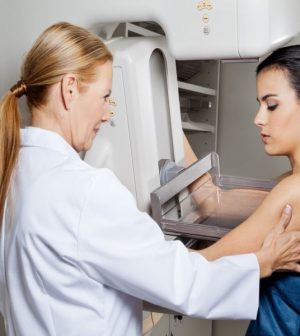- Good Blood Pressure Control Could Prevent Fibroids
- AI Matches Experts in Spotting Radiology Errors
- Melatonin Gummies to Get Safety Labeling, Child-Safe Bottles After Poisonings
- CDC Warns of 19 Cases of Botched Botox Shots in 9 States
- A More Diverse Nature Brings Better Mental Health
- Blinking: It’s About More Than Moistening the Eye
- Brain’s Cerebellum Could Help Direct Prosthetic Limbs
- Complications in Pregnancy Linked to Long-Term Health Risks for Women
- ‘One and Done’: Scientists Develop Vaccine That May Fight Any Viral Strain
- Walking Your Way to Better Health
How Benign Are ‘Benign’ Breast Findings? Study Finds Link to Higher Cancer Risk

Many women feel a lump in their breast or receive an abnormal result on a screening mammogram that turns out to be a cyst or other type of non-cancerous growth.
With this news comes a huge sigh of relief, but it may not be the end of the story, new research suggests.
While these growths are not cancerous, their presence may increase the risk of breast cancer down the road. Women who have benign breast conditions, such as cysts and fibroadenomas, are almost twice as likely to be diagnosed with breast cancer in the next 20 years, researchers from Spain reported.
The new findings should “encourage women with benign breast lesions to participate in breast cancer screening programs because they are at an increased risk and they might benefit [from] a higher degree of breast cancer early detection,” said study author Marta Román, an epidemiologist at the Hospital del Mar in Barcelona.
“Because women with a benign breast disease are at an increased risk for breast cancer, the information on benign breast disease, together with information on [breast] density, age, and family history of breast cancer can be used to define risk groups to design personalized screening strategies,” she said.
For example, someone without benign breast disease, dense breast tissue, or a family history of breast cancer might be offered screening with standard mammography every three or four years instead of every two years. Meanwhile, someone at high risk with dense breasts, a first-degree family history of breast cancer and/or benign breast disease might be offered screening mammography or even MRI every year.
In Spain, women between 50 and 69 years of age are screened for breast cancer every two years. The American Cancer Society suggests women between 45 and 54 years of age get mammograms every year. After that, older women can switch to every other year or continue yearly screening.
Benign breast lesions might be risk factors for breast cancer, Román said.
“Instead of the benign lesion progressing through time to an incident breast cancer, which is the common thinking, they are markers of an increased likelihood of developing breast cancer in the future,” she said.
These growths are caused by an increase in breast tissue and certain cells within the breast, and the more tissue and cells, the greater the chances of abnormalities developing that may later turn into cancer.
For the study, the researchers compared breast cancer risk among more than 770,000 women. Of these, about 17,800 women were diagnosed with benign breast disease, and roughly 11,700 were diagnosed with breast cancer during about 20 years of follow-up.
Women with a history of benign breast growth including fibroadenomas and cysts were more likely to be diagnosed with breast cancer. This risk persisted for at least two decades and held regardless of age, the study found.
About 25 in every 1,000 women with benign breast disease were diagnosed with breast cancer. By contrast, around 15 of every 1,000 women without a history of benign breast disease were diagnosed with breast cancer during the study period.
The findings, which were published earlier this year in the International Journal of Environmental Research and Public Health, were also presented Thursday at the European Breast Cancer Conference, in Barcelona.
After a person learns their breast biopsy is benign, there is a strong desire to return to normal and set aside cancer fears, said Dr. Marisa Weiss, chief medical officer and founder of Breastcancer.org in Ardmore, Pa.
And the good news is that most of these women will never develop breast cancer, she said.
“This study shows that extra benign breast cell growth can lead to extra abnormal cell growth, including a higher risk of developing breast cancer in the future,” said Weiss, who reviewed the findings.
“It is important for women who have a benign breast biopsy to assess all of their breast cancer risks together, [including] family history, inherited genetic testing, lifestyle considerations and to create a customized plan of surveillance and risk reduction over time,” Weiss said.
More information
Breastcancer.org has more on benign breast growths.
SOURCES: Marta Román, PhD, epidemiologist, Hospital del Mar, Barcelona, Spain; Marisa Weiss, MD, chief medical officer, founder, Breastcancer.org, Ardmore, Pa.; presentation, European Breast Cancer Conference, Barcelona, Nov. 17, 2022; Journal of Environmental Research and Public Health, Feb. 24, 2022, online
Source: HealthDay
Copyright © 2024 HealthDay. All rights reserved.










